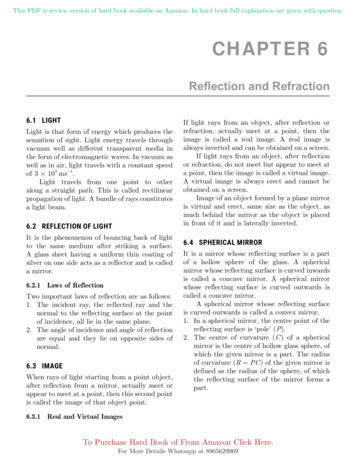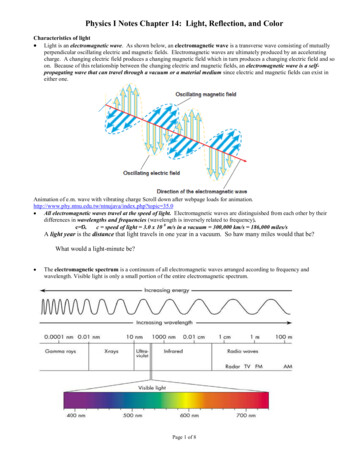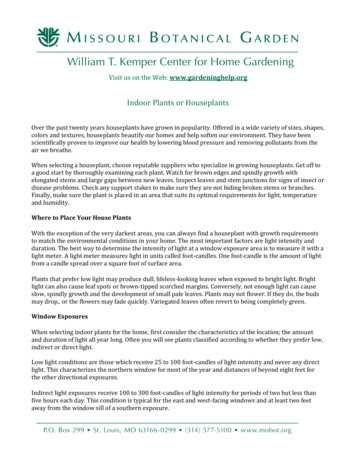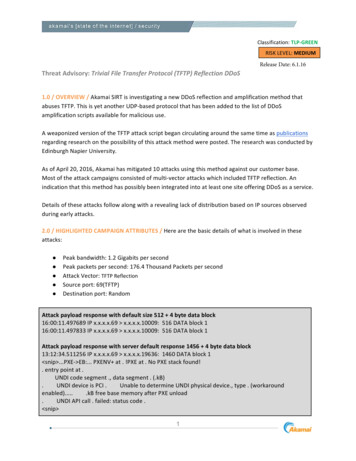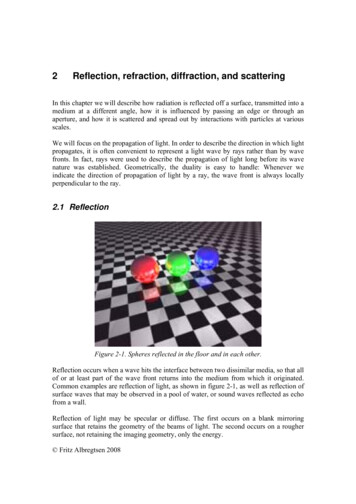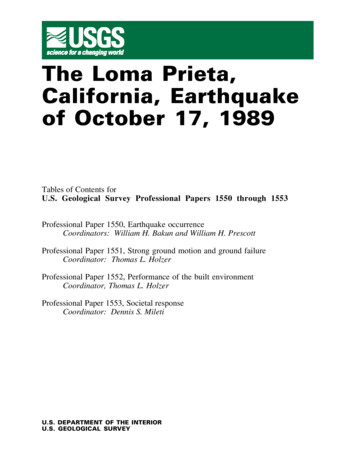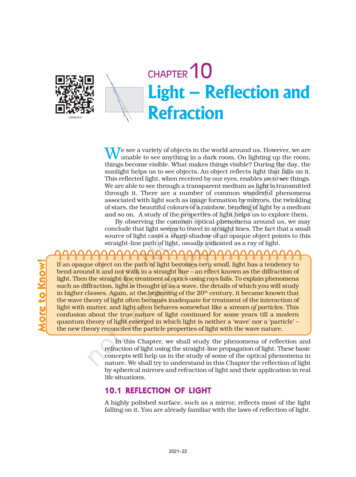
Transcription
CHAPTER10Light – Reflection andRefractionWMore to Know!e see a variety of objects in the world around us. However, we areunable to see anything in a dark room. On lighting up the room,things become visible. What makes things visible? During the day, thesunlight helps us to see objects. An object reflects light that falls on it.This reflected light, when received by our eyes, enables us to see things.We are able to see through a transparent medium as light is transmittedthrough it. There are a number of common wonderful phenomenaassociated with light such as image formation by mirrors, the twinklingof stars, the beautiful colours of a rainbow, bending of light by a mediumand so on. A study of the properties of light helps us to explore them.By observing the common optical phenomena around us, we mayconclude that light seems to travel in straight lines. The fact that a smallsource of light casts a sharp shadow of an opaque object points to thisstraight-line path of light, usually indicated as a ray of light.If an opaque object on the path of light becomes very small, light has a tendency tobend around it and not walk in a straight line – an effect known as the diffraction oflight. Then the straight-line treatment of optics using rays fails. To explain phenomenasuch as diffraction, light is thought of as a wave, the details of which you will studyin higher classes. Again, at the beginning of the 20th century, it became known thatthe wave theory of light often becomes inadequate for treatment of the interaction oflight with matter, and light often behaves somewhat like a stream of particles. Thisconfusion about the true nature of light continued for some years till a modernquantum theory of light emerged in which light is neither a ‘wave’ nor a ‘particle’ –the new theory reconciles the particle properties of light with the wave nature.In this Chapter, we shall study the phenomena of reflection andrefraction of light using the straight-line propagation of light. These basicconcepts will help us in the study of some of the optical phenomena innature. We shall try to understand in this Chapter the reflection of lightby spherical mirrors and refraction of light and their application in reallife situations.10.1 REFLECTION OF LIGHTA highly polished surface, such as a mirror, reflects most of the lightfalling on it. You are already familiar with the laws of reflection of light.Science1602021–22
Let us recall these laws –(i) The angle of incidence is equal to the angle of reflection, and(ii) The incident ray, the normal to the mirror at the point of incidenceand the reflected ray, all lie in the same plane.These laws of reflection are applicable to all types of reflecting surfacesincluding spherical surfaces. You are familiar with the formation of imageby a plane mirror. What are the properties of the image? Image formedby a plane mirror is always virtual and erect. The size of the image isequal to that of the object. The image formed is as far behind the mirroras the object is in front of it. Further, the image is laterally inverted.How would the images be when the reflecting surfaces are curved? Letus explore.Activity 10.1nnnnnTake a large shining spoon. Try to view your face in its curvedsurface.Do you get the image? Is it smaller or larger?Move the spoon slowly away from your face. Observe the image.How does it change?Reverse the spoon and repeat the Activity. How does the imagelook like now?Compare the characteristics of the image on the two surfaces.The curved surface of a shining spoon could be considered as a curvedmirror. The most commonly used type of curved mirror is the sphericalmirror. The reflecting surface of such mirrors can be considered to forma part of the surface of a sphere. Such mirrors, whose reflecting surfacesare spherical, are called spherical mirrors. We shall now study aboutspherical mirrors in some detail.AL MIRRORS10.2 SPHERICSPHERICALThe reflecting surface of a spherical mirror may be curved inwards oroutwards. A spherical mirror, whose reflecting surface is curved inwards,that is, faces towards the centre of the sphere, is called a concave mirror.A spherical mirror whose reflecting surface is curved outwards, is calleda convex mirror. The schematic representation of these mirrors is shownin Fig. 10.1. You may note in these diagrams that the backof the mirror is shaded.You may now understand that the surface of the spooncurved inwards can be approximated to a concave mirrorand the surface of the spoon bulged outwards can beapproximated to a convex mirror.Before we move further on spherical mirrors, we need torecognise and understand the meaning of a few terms. These(a) Concave mirror(b) Convex mirrorterms are commonly used in discussions about sphericalmirrors. The centre of the reflecting surface of a spherical Figure 10.1mirror is a point called the pole. It lies on the surface of the Schematic representation of sphericalmirrors; the shaded side is non-reflecting.mirror. The pole is usually represented by the letter P.161Light – Reflection and Refraction2021–22
The reflecting surface of a spherical mirror forms a part of a sphere.This sphere has a centre. This point is called the centre of curvature ofthe spherical mirror. It is represented by the letter C. Please note that thecentre of curvature is not a part of the mirror. It lies outside its reflectingsurface. The centre of curvature of a concave mirror lies in front of it.However, it lies behind the mirror in case of a convex mirror. You maynote this in Fig.10.2 (a) and (b). The radius of the sphere of which thereflecting surface of a spherical mirror forms a part, is called the radiusof curvature of the mirror. It is represented by the letter R. You may notethat the distance PC is equal to the radius of curvature. Imagine a straightline passing through the pole and the centre of curvature of a sphericalmirror. This line is called the principal axis. Remember that principalaxis is normal to the mirror at its pole. Let us understand an importantterm related to mirrors, through an Activity.Activity 10.2nnnn(a)(b)Figure 10.2(a) Concave mirror(b) Convex mirrorCAUTION: Do not look at the Sun directly or even into a mirrorreflecting sunlight. It may damage your eyes.Hold a concave mirror in your hand and direct its reflecting surfacetowards the Sun.Direct the light reflected by the mirror on to a sheet of paper heldclose to the mirror.Move the sheet of paper back and forth gradually until you findon the paper sheet a bright, sharp spot of light.Hold the mirror and the paper in the same position for a fewminutes. What do you observe? Why?The paper at first begins to burn producing smoke. Eventually itmay even catch fire. Why does it burn? The light from the Sun is convergedat a point, as a sharp, bright spot by the mirror. In fact, this spot of lightis the image of the Sun on the sheet of paper. This point isthe focus of the concave mirror. The heat produced due tothe concentration of sunlight ignites the paper. The distanceof this image from the position of the mirror gives theapproximate value of focal length of the mirror.Let us try to understand this observation with the helpof a ray diagram.Observe Fig.10.2 (a) closely. A number of rays parallelto the principal axis are falling on a concave mirror. Observethe reflected rays. They are all meeting/intersecting at apoint on the principal axis of the mirror. This point is calledthe principal focus of the concave mirror. Similarly, observeFig. 10.2 (b). How are the rays parallel to the principal axis,reflected by a convex mirror? The reflected rays appear tocome from a point on the principal axis. This point is calledthe principal focus of the convex mirror. The principal focusis represented by the letter F. The distance between thepole and the principal focus of a spherical mirror is calledthe focal length. It is represented by the letter f.Science1622021–22
The reflecting surface of a spherical mirror is by-and-large spherical.The surface, then, has a circular outline. The diameter of the reflectingsurface of spherical mirror is called its aperture. In Fig.10.2, distanceMN represents the aperture. We shall consider in our discussion onlysuch spherical mirrors whose aperture is much smaller than its radiusof curvature.Is there a relationship between the radius of curvature R, and focallength f, of a spherical mirror? For spherical mirrors of small apertures,the radius of curvature is found to be equal to twice the focal length. Weput this as R 2f . This implies that the principal focus of a sphericalmirror lies midway between the pole and centre of curvature.10.2.1 Image Formation by Spherical MirrorsYou have studied about the image formation by plane mirrors. You alsoknow the nature, position and relative size of the images formed by them.How about the images formed by spherical mirrors? How can we locatethe image formed by a concave mirror for different positions of the object?Are the images real or virtual? Are they enlarged, diminished or havethe same size? We shall explore this with an Activity.Activity 10.3You have already learnt a way of determining the focal length of aconcave mirror. In Activity 10.2, you have seen that the sharp brightspot of light you got on the paper is, in fact, the image of the Sun. Itwas a tiny, real, inverted image. You got the approximate focal lengthof the concave mirror by measuring the distance of the image fromthe mirror.n Take a concave mirror. Find out its approximate focal length inthe way described above. Note down the value of focal length. (Youcan also find it out by obtaining image of a distant object on asheet of paper.)n Mark a line on a Table with a chalk. Place the concave mirror ona stand. Place the stand over the line such that its pole lies overthe line.n Draw with a chalk two more lines parallel to the previous linesuch that the distance between any two successive lines is equalto the focal length of the mirror. These lines will now correspondto the positions of the points P, F and C, respectively. Remember –For a spherical mirror of small aperture, the principal focus F liesmid-way between the pole P and the centre of curvature C.n Keep a bright object, say a burning candle, at a position far beyondC. Place a paper screen and move it in front of the mirror till youobtain a sharp bright image of the candle flame on it.n Observe the image carefully. Note down its nature, position andrelative size with respect to the object size.n Repeat the activity by placing the candle – (a) just beyond C,(b) at C, (c) between F and C, (d) at F, and (e) between P and F.n In one of the cases, you may not get the image on the screen.Identify the position of the object in such a case. Then, look for itsvirtual image in the mirror itself.n Note down and tabulate your observations.163Light – Reflection and Refraction2021–22
You will see in the above Activity that the nature, position and size ofthe image formed by a concave mirror depends on the position of theobject in relation to points P, F and C. The image formed is real for somepositions of the object. It is found to be a virtual image for a certain otherposition. The image is either magnified, reduced or has the same size,depending on the position of the object. A summary of these observationsis given for your reference in Table 10.1.Table 10.1 Image formation by a concave mirror for different positions of the objectPosition of theobjectPosition of theimageSize of theimageNature of theimageAt infinityAt the focus FHighly diminished,point-sizedReal and invertedBeyond CBetween F and CDiminishedReal and invertedAt CAt CSame sizeReal and invertedBetween C and FBeyond CEnlargedReal and invertedAt FAt infinityHighly enlargedReal and invertedBetween P and FBehind the mirrorEnlargedVirtual and erect10.2.2 Representation of Images Formed by SphericalMirrors Using Ray DiagramsWe can also study the formation of images by spherical mirrors bydrawing ray diagrams. Consider an extended object, of finite size, placedin front of a spherical mirror. Each small portion of the extended objectacts like a point source. An infinite number of rays originate from eachof these points. To construct the ray diagrams, in order to locate theimage of an object, an arbitrarily large number of rays emanating from apoint could be considered. However, it is more convenient to consideronly two rays, for the sake of clarity of the ray diagram. These rays areso chosen that it is easy to know their directions after reflection from themirror.The intersection of at least two reflected rays give the position of imageof the point object. Any two of the following rays can be considered forlocating the image.(a)Figure 10.3(b)(i) A ray parallel to theprincipalaxis,afterreflection, will pass throughthe principal focus in case ofa concave mirror or appearto diverge from the principalfocus in case of a convexmirror. This is illustrated inFig.10.3 (a) and (b).Science1642021–22
(ii) A ray passing through theprincipal focus of a concavemirror or a ray which isdirected towards theprincipal focus of a convexmirror, after reflection, willemerge parallel to theprincipal axis. This isillustrated in Fig.10.4 (a)and (b).(iii) A ray passing through thecentre of curvature of aconcave mirror or directedin the direction of the centreof curvature of a convexmirror, after reflection, isreflected back along thesame path.This isillustrated in Fig.10.5 (a)and (b). The light rays comeback along the same pathbecause the incident raysfall on the mirror along thenormal to the reflectingsurface.(iv) A ray incident obliquely tothe principal axis, towardsa point P (pole of the mirror),on the concave mirror[Fig. 10.6 (a)] or a convexmirror [Fig. 10.6 (b)], isreflected obliquely. Theincident and reflected raysfollow the laws of reflectionat the point of incidence(point P), making equalangles with the principal axis.(a)(b)Figure 10.4(b)(a)Figure 10.5(a)(b)Figure 10.6Remember that in all the above cases the laws of reflection are followed.At the point of incidence, the incident ray is reflected in such a way thatthe angle of reflection equals the angle of incidence.(a)Image formation by Concave MirrorFigure 10.7 illustrates the ray diagrams for the formation of imageby a concave mirror for various positions of the object.165Light – Reflection and Refraction2021–22
Figure 10.7 Ray diagrams for the image formation by a concave mirrorActivity 10.4nnnnnDraw neat ray diagrams for each position of the object shown inTable 10.1.You may take any two of the rays mentioned in the previous sectionfor locating the image.Compare your diagram with those given in Fig. 10.7.Describe the nature, position and relative size of the image formedin each case.Tabulate the results in a convenient format.Uses of concave mirrorsConcave mirrors are commonly used in torches, search-lights andvehicles headlights to get powerful parallel beams of light. They areoften used as shaving mirrors to see a larger image of the face. Thedentists use concave mirrors to see large images of the teeth of patients.Large concave mirrors are used to concentrate sunlight to produceheat in solar furnaces.(b)Image formation by a Convex MirrorWe studied the image formation by a concave mirror. Now we shallstudy the formation of image by a convex mirror.Science1662021–22
Activity 10.5nnnnnTake a convex mirror. Hold it in one hand.Hold a pencil in the upright position in the other hand.Observe the image of the pencil in the mirror. Is the image erect orinverted? Is it diminished or enlarged?Move the pencil away from the mirror slowly. Does the imagebecome smaller or larger?Repeat this Activity carefully. State whether the image will movecloser to or farther away from the focus as the object is movedaway from the mirror?We consider two positions of the object for studying the image formedby a convex mirror. First is when the object is at infinity and the secondposition is when the object is at a finite distance from the mirror. The raydiagrams for the formation of image by a convex mirror for these twopositions of the object are shown in Fig.10.8 (a) and (b), respectively.The results are summarised in Table 10.2.Figure 10.8 Formation of image by a convex mirrorTable 10.2 Nature, position and relative size of the image formed by a convex mirrorPosition of theobjectPosition of theimageSize of theimageNature of theimageAt infinityAt the focus F,behind the mirrorHighly diminished,point-sizedVirtual and erectBetween infinityand the pole P ofthe mirrorBetween P and F,behind the mirrorDiminishedVirtual and erectYou have so far studied the image formation by a plane mirror, aconcave mirror and a convex mirror. Which of these mirrors will give thefull image of a large object? Let us explore through an Activity.Activity 10.6nnObserve the image of a distant object, say a distant tree, in aplane mirror.Could you see a full-length image?167Light – Reflection and Refraction2021–22
nnnTry with plane mirrors of different sizes. Did you see the entireobject in the image?Repeat this Activity with a concave mirror. Did the mirror showfull length image of the object?Now try using a convex mirror. Did you succeed? Explain yourobservations with reason.You can see a full-length image of a tall building/tree in a smallconvex mirror. One such mirror is fitted in a wall of Agra Fort facing TajMahal. If you visit the Agra Fort, try to observe the full image of TajMahal. To view distinctly, you should stand suitably at the terraceadjoining the wall.Uses of convex mirrorsConvex mirrors are commonly used as rear-view (wing) mirrors invehicles. These mirrors are fitted on the sides of the vehicle, enabling thedriver to see traffic behind him/her to facilitate safe driving. Convexmirrors are preferred because they always give an erect, thoughdiminished, image. Also, they have a wider field of view as they are curvedoutwards. Thus, convex mirrors enable the driver to view much largerarea than would be possible with a plane mirror.QUESTIONS1.Define the principal focus of a concave mirror.2.The radius of curvature of a spherical mirror is 20 cm. What is its focallength?3.Name a mirror that can give an erect and enlarged image of an object.4.Why do we prefer a convex mirror as a rear-view mirror in vehicles?10.2.3 Sign Convention for Reflection by Spherical MirrorsWhile dealing with the reflection of light by spherical mirrors, we shallfollow a set of sign conventions called the New Cartesian SignConvention. In this convention, the pole (P) of the mirror is taken as theorigin (Fig. 10.9). The principal axis of the mirror is taken as the x-axis(X’X) of the coordinate system. The conventions are as follows –(i) The object is always placed to the left of the mirror. This impliesthat the light from the object falls on the mirror from the left-handside.(ii) All distances parallel to the principal axis are measured from thepole of the mirror.(iii) All the distances measured to the right of the origin (along x-axis) are taken as positive while those measured to the left ofthe origin (along – x-axis) are taken as negative.(iv) Distances measured perpendicular to and above the principal axis(along y-axis) are taken as positive.(v) Distances measured perpendicular to and below the principal axis(along –y-axis) are taken as negative.Science1682021–22
The New Cartesian Sign Convention described above is illustrated inFig.10.9 for your reference. These sign conventions are applied to obtainthe mirror formula and solve related numerical problems.10.2.4 Mirror Formula and MagnificationIn a spherical mirror, the distance of theobject from its pole is called the objectdistance (u). The distance of the image fromthe pole of the mirror is called the imagedistance (v). You already know that thedistance of the principal focus from the poleis called the focal length (f) . There is arelationship between these three quantitiesgiven by the mirror formula which isexpressed as1 11 v uf(10.1)This formula is valid in all situations for allspherical mirrors for all positions of theobject. You must use the New Cartesian SignConvention while substituting numericalvalues for u, v, f, and R in the mirror formulafor solving problems.Figure 10.9The New Cartesian Sign Convention for spherical mirrorsMagnificationMagnification produced by a spherical mirror gives the relative extent towhich the image of an object is magnified with respect to the object size.It is expressed as the ratio of the height of the image to the height of theobject. It is usually represented by the letter m.If h is the height of the object and h ′ is the height of the image, thenthe magnification m produced by a spherical mirror is given byHeight of the image (h ′ )m Height of the object (h )m h′h(10.2)The magnification m is also related to the object distance (u) andimage distance (v). It can be expressed as:h′v (10.3)huYou may note that the height of the object is taken to be positive asthe object is usually placed above the principal axis. The height of theimage should be taken as positive for virtual images. However, it is to betaken as negative for real images. A negative sign in the value of themagnification indicates that the image is real. A positive sign in the valueof the magnification indicates that the image is virtual.Magnification (m) 169Light – Reflection and Refraction2021–22
Example 10.1A convex mirror used for rear-view on an automobile has a radius ofcurvature of 3.00 m. If a bus is located at 5.00 m from this mirror,find the position, nature and size of the image.SolutionRadius of curvature, R 3.00 m;Object-distance,u – 5.00 m;Image-distance,v ?Height of the image, h ′ ?Focal length, f R/2 3.00 m 1.50 m (as the principal focus of2a convex mirror is behind the mirror)Sinceor, 1 11 v uf1 1 11111 – 1.501.50 5.00vf u( 5.00)5.00 1.507.50 7.50 1.15 m6.50The image is 1.15 m at the back of the mirror.v Magnification, m 1.15 mh'v – 5.00 mhu 0.23The image is virtual, erect and smaller in size by a factor of 0.23.Example 10.2An object, 4.0 cm in size, is placed at 25.0 cm in front of a concavemirror of focal length 15.0 cm. At what distance from the mirrorshould a screen be placed in order to obtain a sharp image? Findthe nature and the size of the image.SolutionObject-size, h 4.0 cm;Object-distance, u – 25.0 cm;Focal length, f –15.0 cm;Image-distance, v ?Image-size, h ′ ?From Eq. (10.1):1 11 v ufor,1 111111 vfu 15.0 25.015.025.0Science1702021–22
or,1 5.0 3.0 2.0 or, v – 37.5 cmv75.075.0The screen should be placed at 37.5 cm in front of the mirror. Theimage is real.Also, magnification, m or, h ′ –h'v hu( 37.5 cm) ( 4.0 cm)vh ( 25.0 cm)uHeight of the image, h ′ – 6.0 cmThe image is inverted and enlarged.QUESTIONS1.Find the focal length of a convex mirror whose radius of curvature is32 cm.2.A concave mirror produces three times magnified (enlarged) real imageof an object placed at 10 cm in front of it. Where is the image located?10.3 REFRACTION OF LIGHTLight seems to travel along straight-line paths in a transparent medium.What happens when light enters from one transparent medium toanother? Does it still move along a straight-line path or change itsdirection? We shall recall some of our day-to-day experiences.You might have observed that the bottom of a tank or a pondcontaining water appears to be raised. Similarly, when a thick glass slabis placed over some printed matter, the letters appear raised when viewedthrough the glass slab. Why does it happen? Have you seen a pencilpartly immersed in water in a glass tumbler? It appears to be displacedat the interface of air and water. You might have observed that a lemonkept in water in a glass tumbler appears to be bigger than its actualsize, when viewed from the sides. How can you account for suchexperiences?Let us consider the case of the apparent displacement of a pencil,partly immersed in water. The light reaching you from the portion of thepencil inside water seems to come from a different direction, comparedto the part above water. This makes the pencil appear to be displaced atthe interface. For similar reasons, the letters appear to be raised, whenseen through a glass slab placed over it.Does a pencil appear to be displaced to the same extent, if instead ofwater, we use liquids like kerosene or turpentine? Will the letters appearto rise to the same height if we replace a glass slab with a transparentplastic slab? You will find that the extent of the effect is different fordifferent pair of media. These observations indicate that light does not171Light – Reflection and Refraction2021–22
travel in the same direction in all media. It appears that when travellingobliquely from one medium to another, the direction of propagation oflight in the second medium changes. This phenomenon is known asrefraction of light. Let us understand this phenomenon further by doinga few activities.Activity 10.7Place a coin at the bottom of a bucket filled with water.With your eye to a side above water, try to pick up the coin in onego. Did you succeed in picking up the coin?Repeat the Activity. Why did you not succeed in doing it in one go?Ask your friends to do this. Compare your experience with theirs.nnnnActivity 10.8nnnnPlace a large shallow bowl on a Table and put a coin in it.Move away slowly from the bowl. Stop when the coin justdisappears from your sight.Ask a friend to pour water gently into the bowl without disturbingthe coin.Keep looking for the coin from your position. Does the coin becomesvisible again from your position? How could this happen?The coin becomes visible again on pouring water into the bowl. Thecoin appears slightly raised above its actual position due to refraction oflight.Activity 10.9nnnnnDraw a thick straight line in ink, over a sheet of white paper placedon a Table.Place a glass slab over the line in such a way that one of its edgesmakes an angle with the line.Look at the portion of the line under the slab from the sides. Whatdo you observe? Does the line under the glass slab appear to bebent at the edges?Next, place the glass slab such that it is normal to the line. Whatdo you observe now? Does the part of the line under the glass slabappear bent?Look at the line from the top of the glass slab. Does the part of theline, beneath the slab, appear to be raised? Why does this happen?10.3.1 Refraction through a Rectangular Glass SlabTo understand the phenomenon of refraction of light through a glassslab, let us do an Activity.Science1722021–22
Activity 10.10nnnnnnnnnFix a sheet of white paper on a drawing board using drawing pins.Place a rectangular glass slab over the sheet in the middle.Draw the outline of the slab with a pencil. Let us name the outlineas ABCD.Take four identical pins.Fix two pins, say E and F, vertically such that the line joining thepins is inclined to the edge AB.Look for the images of the pins E and F through the opposite edge.Fix two other pins, say G and H, such that these pins and theimages of E and F lie on a straight line.Remove the pins and the slab.Join the positions of tip of the pins E and F and produce the lineup to AB. Let EF meet AB at O. Similarly, join the positions of tipof the pins G and H and produce it up to the edge CD. Let HGmeet CD at O′.Join O and O′. Also produce EF up to P, as shown by a dotted linein Fig. 10.10.In this Activity, you will note, the light ray has changed its directionat points O and O′. Note that both the points O and O′ lie on surfacesseparating two transparent media. Draw a perpendicular NN’ to AB at Oand another perpendicular MM′ to CD at O′. The light ray at point O hasentered from a rarer medium to a denser medium, that is, from air toglass. Note that the light ray has bent towardsthe normal. At O′, the light ray has enteredfrom glass to air, that is, from a densermedium to a rarer medium. The light herehas bent away from the normal. Compare theangle of incidence with the angle of refractionat both refracting surfaces AB and CD.In Fig. 10.10, a ray EO is obliquelyincident on surface AB, called incident ray.OO′ is the refracted ray and O′ H is theemergent ray. You may observe that theemergent ray is parallel to the direction ofthe incident ray. Why does it happen so? Theextent of bending of the ray of light at theopposite parallel faces AB (air-glass interface)and CD (glass-air interface) of the rectangularglass slab is equal and opposite. This is whythe ray emerges parallel to the incident ray.However, the light ray is shifted sideward Figure 10.10slightly. What happens when a light ray is Refraction of light through a rectangular glass slabincident normally to the interface of twomedia? Try and find out.Now you are familiar with the refraction of light. Refraction is due tochange in the speed of light as it enters from one transparent medium toanother. Experiments show that refraction of light occurs according tocertain laws.173Light – Reflection and Refraction2021–22
The following are the laws of refraction of light.(i) The incident ray, the refracted ray and the normal to the interfaceof two transparent media at the point of incidence, all lie in thesame plane.(ii) The ratio of sine of angle of incidence to the sine of angle ofrefraction is a constant, for the light of a given colour and forthe given pair of media. This law is also known as Snell’s law ofrefraction. (This is true for angle 0 i 90o)If i is the angle of incidence and r is the angle of refraction, then,sin i constantsin r(10.4)This constant value is called the refractive index of the second mediumwith respect to the first. Let us study about refractive index in some detail.10.3.2 The Refractive IndexYou have already studied that a ray of light that travels obliquely fromone transparent medium into another will change its direction in thesecond medium. The extent of the change
source of light casts a sharp shadow of an opaque object points to this straight-line path of light, usually indicated as a ray of light. Mor e to Know! If an opaque object on the path of light becomes bend around it and not walk in a straight line – an effect known as the

